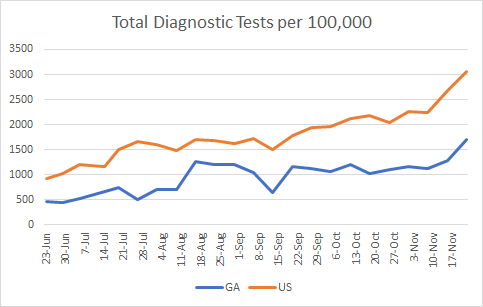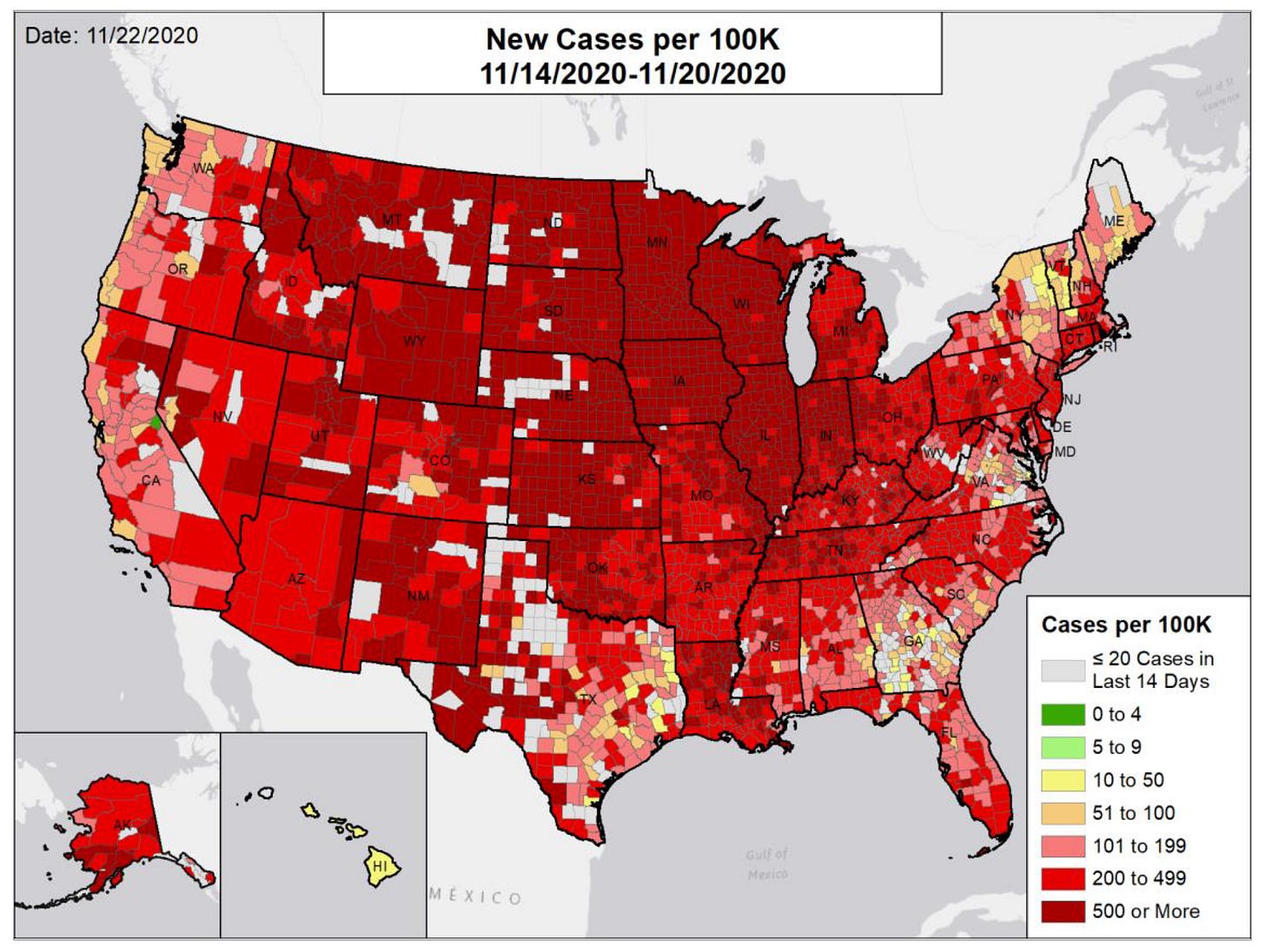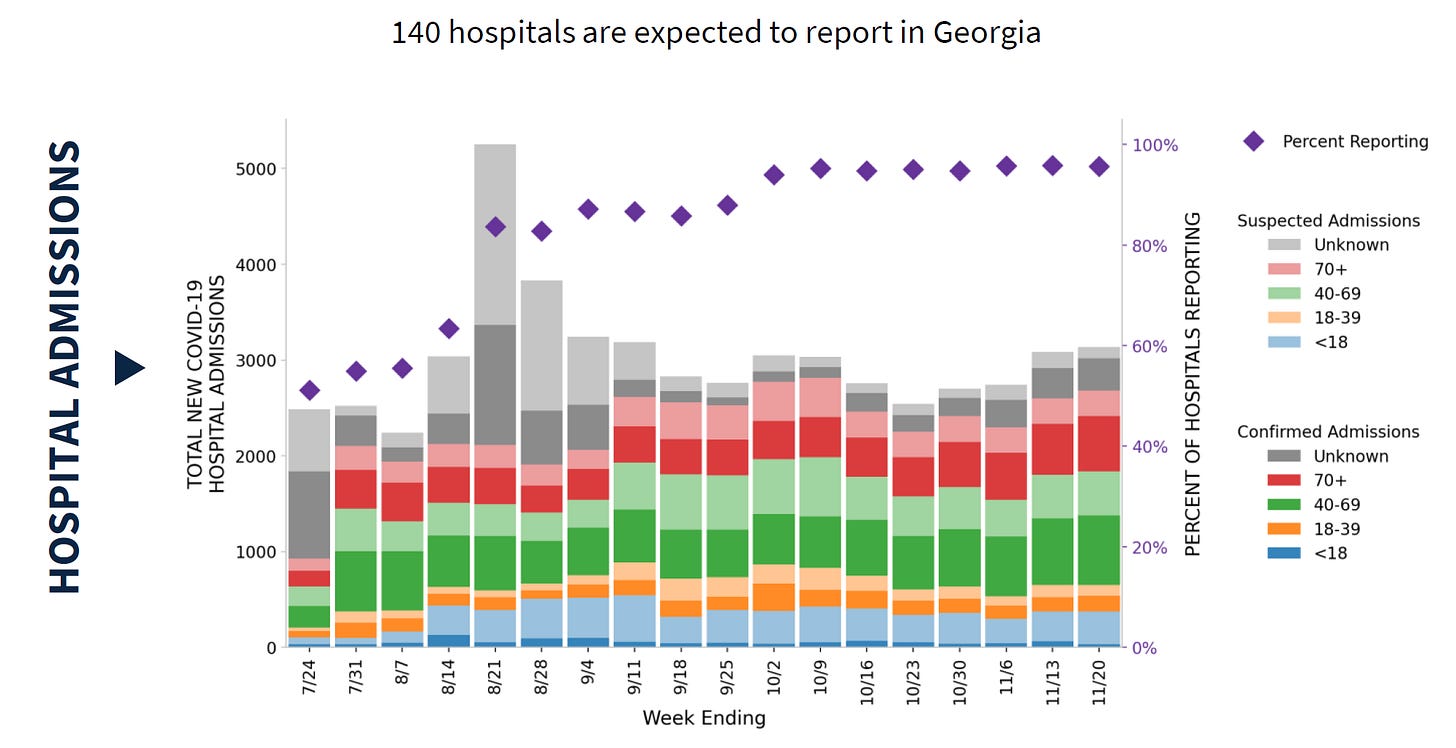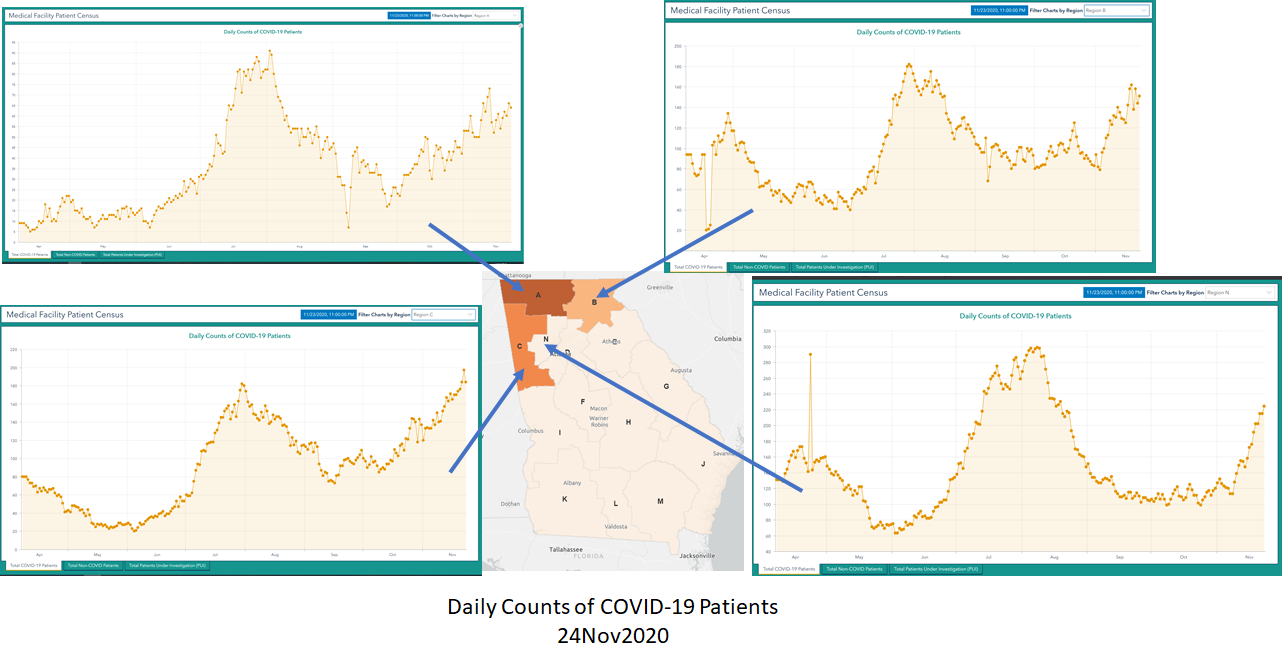Good afternoon! Today we’ll discuss the most recent White House Coronavirus Task Force Report for the state of Georgia and the latest numbers from DPH. Be prepared for the case numbers to stall this week as we have the Thanksgiving holiday. Testing centers and laboratories will likely have reduced hours, if they’re open at all, and reporting will be delayed. Then, we need to be prepared for really large increases in numbers next week as the backlog of specimens are processed and reported. Some of that increase will be real, there’s a lot of momentum for the virus right now, but some of the increase will be an artifact of the holiday impact.
First, here’s the summary table from the latest report, which you can review in its entirety here. There’s a new color coding scheme with three shades of red now, to better describe the extremely high numbers in some of the states. There’s also a new row at the bottom for COVID-19 hospital admissions.
Perhaps the most meaningful difference in this week’s report compared to past weeks is this statement in the summary section on the first page:
“Georgia has seen an increase in new cases and stability in test positivity and is in the early stages of full resurgence. This is the moment to dramatically increase mitigation.” - The White House Coronavirus Task Force report for Georgia, 11.22.2020
Unfortunately, at yesterday’s press briefing, the Governor has decided to let that moment pass. He described the recent increases in cases as a “little bump.” The graph below shows the recent case increase.
It looks as though we are in the midst of exponential growth, and this graph only considers the PCR-based cases. The situation is even more dire if you also include the antigen cases. So describing this as a “little bump” is a missed opportunity, especially for the Governor to make a meaningful statement regarding the seriousness of this disease to rural communities that don’t benefit from the public messaging campaigns available in urban and nonrural communities and where the death rate is 73% higher than the state average. It also undercuts his own message (as well as that of the DPH) for Georgians to take things seriously and limit their exposures over Thanksgiving when he minimizes the importance of this rise in cases as a “little bump.” I mean, we are asking people to cancel or limit their Thanksgiving gatherings and that is a BIG ask. I doubt people are going to take the more careful approach when the Governor implies that the increase is no big deal. This ambivalence breeds complacency.
Testing
The testing rate is growing for both the US and the state of Georgia. But the US rate remains 80% higher than Georgia’s test rate.
The percent positive rate continues to trend upward for the US, although this week’s increase is not as dramatic as the previous weeks. For Georgia, the rate is roughly equal to the previous week, at 8% and above the 5% goal.
For test positivity, Georgia is ranked 39th in the nation, in the orange zone.
Today in Georgia, the state reported 21,986 new PCR test results which is a low number, especially considering how much demand for tests we’ve been seeing with people seeking tests prior to Thanksgiving gatherings. Of the tests reported today, 8.4% were positive. The state of Georgia does not provide data regarding the number of antigen tests performed or the percent of them that are positive.
Cases
The case rate is also growing for both the state as well as the nation. If Georgia is going to see a similar increase to the US, we are starting it from a delay of about 3 weeks. At present, the Georgia case rate is 55% less than the national rate. However, it’s important to remember that the WHCTF uses the case data that each state reports to USAFacts.org. Most states include antigen cases in the case total they report while Georgia does not, even though Public Health Commissioner, Dr. Kathleen Toomey confirmed in her remarks at the Governor’s press conference that the DPH treats each of those antigen cases the same as PCR case. So the case rate reported by the WHCTF is an underestimate of Georgia’s reality.
The map below shows how the WHCTF characterizes each county in Georgia. The entire northern half of the state is in the red zone and that extends along the western and eastern borders. There are also red counties along the Georgia coast.
The number of counties on this list of counties of concern for the WHCTF has risen 18% since mid-October. As of this week, 105 of Georgia’s 159 counties are on this list of red, orange or yellow counties.
For new cases per 100,000 in the most recent week, Georgia is ranked 48 in the nation and in the light red zone. Meanwhile, keep in mind that Georgia is not reporting antigen cases to the WHCTF data source, so our case rate is higher than this report is indicating. I mean, we’ve learned through painful experience that the virus doesn’t recognize geopolitical borders. So why would the disease skip over south Georgia on the way to Florida? I think it’s a combination of we aren’t including antigen cases and we aren’t doing active surveillance for cases, against the advice of the WHCTF.
Today, Georgia reported a net increase of 3177 newly reported cases (2358 by PCR, 819 by antigen test). The updated statewide total is 457,909. Of today’s newly reported cases, 39.5% came from nonrural counties outside of the Atlanta metro, 28% came from the Atlanta suburbs, 25% came from rural counties and 15% came from the Atlanta counties of Fulton and DeKalb. You can check to see the classification for your county here.
Hospitalizations
The WHCTF calculates our hospital admission rate to be 19 per 100 available beds, equivalent to the national rate. Considering how hospitalizations are trending nationally, being equal to the national rate is not a good sign. We’ll want to keep an eye on this going forward. Meanwhile, the graph below shows hospital admissions for COVID-19 have trended over time and with age. The darker shade of each color represents confirmed cases - those who already have laboratory results confirming COVID-19 prior to hospital admission. The lighter shade of each color represents suspected cases - those whose symptoms are similar to COVID-19 but who are awaiting laboratory results at the time of admission.
We saw a negligible increase this week compared to last week. One thing I’ll note is that the proportion of children being hospitalized is greater for Georgia than some of the other states I monitor. Children outnumber the hospital admissions for 18-39 year olds, in fact.
A spot of really good news, however, is in the supply of PPE at Georgia hospitals. The image below shows the 11/15 graph for this above the most recent graph. You can see that the proportion of hospitals with 0-3 days of PPE (the darkest shade of purple) has greatly diminished, to less than 5% for the three PPE categories. This is a drastic improvement.
Meanwhile, the “little bump” in cases that the Governor described is having real consequences for COVID-19 hospitalizations in the northern half of the state. You can view the data for each of these hospital regions here, selecting each region from the drop down menu in the upper right. But pay attention to the trends in the graphs below, for now. I’ve pointed to the region they represent in the Georgia map below. Each graph shows the currently hospitalized patient population for each of those hospital regions.
Hospital region C (west border of Georgia) is seeing more patients currently hospitalized for COVID-19 than they experienced during the peak of the summer surge. The number of patients currently hospitalized is growing exponentially for region N (the northwest Atlanta suburbs). And concerning increases are also observed for regions A and B along the northern border of Georgia, approaching the peak levels they sustained in the summer.
Today, Georgia recorded 145 patients newly hospitalized for COVID-19 and 20 ICU admissions. The number of patients currently hospitalized is 1950, thirty more than yesterday. The number of patients currently hospitalized hasn’t been this high since 29Aug as we were descending from the summer peak.
Deaths
This week Georgia saw death rate decline while the rate rose for the United States. For new deaths per 100,000 in the most recent week, Georgia is ranked #39 in the nation, in the orange zone.
Today Georgia recorded a net increase of 46 newly reported COVID-19 deaths. The updated statewide total is 8694. Of today’s deaths, 43% came from rural counties, 24% came from nonrural counties outside of the Atlanta metro, 20% came from the Atlanta suburbs and 11% came from the Atlanta counties. Just as we should expect case reporting to slow over the Thanksgiving holiday, we should also expect death reporting to slow. Brace for large numbers next week as reports come in, some of which will be an artifact of the holiday delay.
References
https://www.ajc.com/news/white-house-panel-pushes-georgia-for-stronger-action-on-coronavirus/4FRQMZRRSBH7ZNT52SN2L6RQ6E/
https://apnews.com/article/atlanta-georgia-coronavirus-pandemic-80497b231a6c657cec19646e21172bec
White House Coronavirus Task Force Report, obtained through an open records request to Georgia Department of Public Health and then submitted to the Center for Public Integrity. Many thanks to both organizations for making this document publicly available. https://beta.documentcloud.org/documents/20417041-georgia-11_22_20
https://dph.georgia.gov/covid-19-daily-status-report
https://covid-gagio.hub.arcgis.com/
Georgia COVID-19 Updates is a free newsletter that depends on reader support. If you wish to subscribe please click the link below. There are free and paid options available.
My Ph.D. is in Medical Microbiology and Immunology. I've worked at places like Creighton University, the Centers for Disease Control & Prevention and Mercer University School of Medicine. All thoughts are my professional opinion and should not be considered medical advice.















Amber can't find a way to ask a question - the GA DPH data on % antibody positives had been tracking at 9.x% and suddenly jumped to 9.9% -- it takes a log of positives to move the whole data base. Can you explain what is going on?